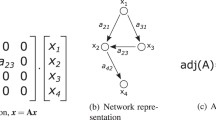Abstract
The common structure of a number of physical network systems is identified, based on the incidence structure of the graph, the weights associated to the edges, and the total stored energy. State variables may not only be associated to the vertices, but also to the edges of the graph; in clear contrast with multiagent systems. Structure-preserving model reduction concerns the problem of approximating a complex physical network system by a system of lesser complexity, but within the same class of physical network systems. Two approaches, respectively, based on clustering and on Kron reduction, are explored.
Access this chapter
Tax calculation will be finalised at checkout
Purchases are for personal use only
Similar content being viewed by others
Notes
- 1.
See for a further discussion [24].
- 2.
The setup can be easily extended (i.e., by using Kronecker products) to the situation that the scalar variable \(x_i\) is replaced by a vector in some higher dimensional physical space, e.g., \(\mathbb {R}^3\); see the remarks later on.
- 3.
Note that \(\mathscr {K}\), and therefore the Laplacian matrix \(\mathscr {L}= B \mathscr {K}B^T\), is dependent on the choice of the thermodynamic equilibrium \(x^*\). However, this dependence is minor: for a connected complex graph the matrix \(\mathscr {K}\) is, up to a positive multiplicative factor, independent of the choice of \(x^*\) [25].
- 4.
For an extension of these results to complex-balanced mass action kinetics reaction networks we refer to [15].
References
Arcak, M.: Passivity as a design tool for group coordination. IEEE Trans. Autom. Control 52(8), 1380–1390 (2007)
Bollobas, B.: Modern Graph Theory, Graduate Texts in Mathematics 184. Springer, New York (1998)
Biyik, E., Arcak, M.: Area aggregation and time-scale modeling for sparse nonlinear networks. Syst. Control Lett. 57(2), 142149 (2007)
Bürger, M., De Persis, C., Trip, S.: An internal model approach to (optimal) frequency regulation in power grids. In: Proceedings IEEE 53rd Annual Conference on Decision and Control (CDC), pp. 223–228, 15–17 Dec 2014
Chow, J.H., Allemong, J.J., Kokotovic, P.V.: Singular perturbation analysis of systems with sustained high frequency oscillations. Automatica 14(3), 271–279 (1978)
DePersis, C., Kallesoe, C.S.: Pressure regulation in nonlinear hydraulic networks by positive and quantized control. IEEE Trans. Control Syst. Technol. 19(6), 1371–1383 (2011)
Dörfler, F., Bullo, F.: Kron reduction of graphs with applications to electrical networks. IEEE Trans. Circ. Syst. I: Regul. Pap. 60(1), 150–163 (2013)
Feinberg, M.: Necessary and sufficient conditions for detailed balancing in mass action systems of arbitrary complexity. Chem. Eng. Sci. 44(9), 1819–1827 (1989)
Godsil, C., Royle, G.: Algebraic graph theory. Springer-Verlag, New York (2001)
Imura, J.-I.: Clustered model reduction of large-scale complex networks. In: Proceedings of the 20th International Symposium on Mathematical Theory of Networks and Systems (MTNS), Melbourne (2012)
Ishizaki, T., Kashida, K., Imura, J.-I., Aihara, K.: Network clustering for SISO linear dynamical networks via reaction-diffusion transformation. In: Proceeding of 18th IFAC World Congress, Milan, Italy, pp. 5639–5644 (2011)
Machovski, J., Bialek, J., Bumby, J.: Power System Dynamics: Stability and Control, 2nd edn. Wiley, Chichester (2008)
Monshizadeh, N., Camlibel, M.K., Trentelman, H.L.: Projection based model reduction of multi-agent systems using graph partitions. IEEE Trans. Control Netw. Syst. 1(2), 145–154 (2014)
Monshizadeh, N., van der Schaft, A.J.: Structure-preserving model reduction of physical network systems by clustering. In: Proceedings 53rd IEEE Conference on Decision and Control, Los Angeles, CA, USA, Dec (2014)
Rao, S., van der Schaft, A.J., Jayawardhana, B.: A graph-theoretical approach for the analysis and model reduction of complex-balanced chemical reaction networks. J. Math. Chem. 51, 2401–2422 (2013)
Rao, S., van der Schaft, A.J., van Eunen, K., Bakker, B.M., Jayawardhana, B.: A model reduction method for biochemical reaction networks. BMC Syst. Biol. 8, 52 (2014)
Romeres, D., Dörfler, F., Bullo, F.: Novel results on slow coherency in consensus and power networks. Eur. Control conf. 742–747 (2013)
Sandberg, H., Murray, R.M.: Model reduction of interconnected linear systems. Optimal Control Appl. Methods 30(3), 225–245 (2009)
van der Schaft, A.J.: \(L_2\)-Gain and Passivity Techniques in Nonlinear Control, Lectures Notes in Control and Information Sciences, Vol. 218, Springer, Berlin (1996). 2nd rev. and enlarged edn. Springer, London (2000)
van der Schaft, A.J.: Characterization and partial synthesis of the behavior of resistive circuits at their terminals. Systems & Control Letters 59, 423–428 (2010)
van der Schaft, A.J.: On model reduction of physical network systems. In: Proceeding of 21st International Symposium on Mathematical Theory of Networks and Systems (MTNS2014), pp. 1419–1425. Groningen, The Netherlands, 7–11 July 2014
van der Schaft, A., Jeltsema, D.: Port-Hamiltonian systems theory: an introductory overview. Found. Trends Syst. Control 1(2/3), 173–378 (2014)
van der Schaft, A.J., Maschke, B.M.: The Hamiltonian formulation of energy conserving physical systems with external ports. Archiv für Elektronik und Übertragungstechnik 49, 362–371 (1995)
van der Schaft, A.J., Maschke, B.M.: Port-Hamiltonian systems on graphs. SIAM J. Control Optim. 51(2), 906–937 (2013)
van der Schaft, A.J., Rao, S., Jayawardhana, B.: On the mathematical structure of balanced chemical reaction networks governed by mass action kinetics. SIAM J. Appl. Math. 73(2), 953–973 (2013)
van der Schaft, A.J., Rao, S, Jayawardhana, B.: Complex and detailed balancing of chemical reaction networks revisited. J. Math. Chem. 53(6), 1445–1458 (2015)
van der Schaft, A.J.: Modeling of physical network systems. In: preparation (2015)
Wegscheider, R.: Über simultane Gleichgewichte und die Beziehungen zwischen Thermodynamik und Reaktionskinetik homogener Systeme. Zetschrift für Physikalische Chemie 39, 257–303 (1902)
Author information
Authors and Affiliations
Corresponding author
Editor information
Editors and Affiliations
Rights and permissions
Copyright information
© 2015 Springer International Publishing Switzerland
About this paper
Cite this paper
van der Schaft, A. (2015). Physical Network Systems and Model Reduction. In: Belur, M., Camlibel, M., Rapisarda, P., Scherpen, J. (eds) Mathematical Control Theory II. Lecture Notes in Control and Information Sciences, vol 462. Springer, Cham. https://doi.org/10.1007/978-3-319-21003-2_11
Download citation
DOI: https://doi.org/10.1007/978-3-319-21003-2_11
Published:
Publisher Name: Springer, Cham
Print ISBN: 978-3-319-21002-5
Online ISBN: 978-3-319-21003-2
eBook Packages: EngineeringEngineering (R0)




